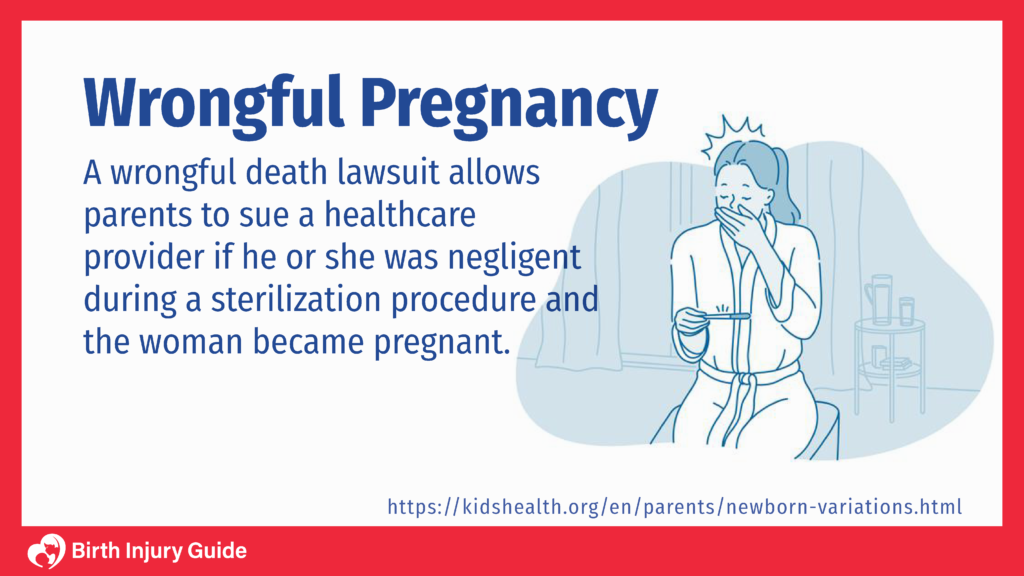
Wrongful Pregnancy
With medical advancements in the past few decades, parents now have the choice to undergo voluntary sterilization if they don’t want to have children or if they choose to stop having children after they feel their family is complete. However, with the increase in sterilization procedures, medical mistakes are increasing as well. Parents who thought they would never have another child again are becoming pregnant, which has led to the concept of wrongful pregnancy.
As a result, a new type of birth injury lawsuit was created – wrongful pregnancy.

However, as long as the sterilization procedure was performed correctly and informed consent was obtained that included the known failure rate, then this lawsuit is meritless.
Wrongful Pregnancy Explained
A wrongful pregnancy lawsuit allows a parent or parents to sue a healthcare provider, pharmaceutical company or any other medical provider that failed to protect the mother from getting pregnant after a sterilization procedure.
The first traces of a wrongful pregnancy lawsuit began in 1934 in the case of Christensen vs. Thornby in the Minnesota Supreme Court. According to court documents, the doctor told the plaintiff and his wife that it would be extremely dangerous for her to have children.
As a result, the plaintiff underwent a vasectomy. Yet, months later, the plaintiff’s wife became pregnant. Although the court decided that no illegal activity took place, it did decide that the defendant, in the case the physician who performed the vasectomy, should be responsible for the financial care of the child.
Financially caring for a child born after a wrongful pregnancy is currently one of the most-debated topics in wrongful pregnancy lawsuits, and most defendants are usually not liable for the costs of raising the child. However, a myriad of similar lawsuits followed, which ultimately led to the creation of the wrongful pregnancy lawsuit.
It’s up to the plaintiff and the plaintiff’s attorney to prove that a wrongful pregnancy did indeed happen. For example, a woman may tell her doctor that she’s uncertain about having children and in turn, the doctor may suggest taking some time to think about it. Should the woman become pregnant, in most cases, this would not indicate a wrongful pregnancy.
However, if the doctor performed a tubal ligation with the sole intention of preventing pregnancy, yet the woman became pregnant anyway, then care needs to be taken to prove that the doctor was negligent either in the performance of the procedure or that she was not properly consented for the procedure. If a vasectomy fails, then the first thing to do is see if a follow-up semen analysis was done to confirm the absence of sperm. The burden of proof must then be established. Afterwards, it’s up to the court to decide the outcome of the lawsuit unless it’s settled outside of court.
Examples of Wrongful Pregnancy
In March of 2014, 44-year-old Cynthia Williams filed a wrongful pregnancy lawsuit against Dr. Byron Rosner of Reproductive Health Associates for a failed sterilization procedure. Mrs. Williams, along with her husband, are both carriers of sickle cell anemia.
Unfortunately, getting pregnant after a tubal ligation isn’t uncommon, and Williams initially had difficulties in obtaining legal representation. However, after research into her medical files, it was determined that Dr. Rosner only sterilized Williams’ right-side fallopian tube, which she had lost during an accident when she was 12-years-old. Her left tube was untouched, which caused her pregnancy.
Another example of wrongful pregnancy occurred in 2003 when Dr. Cattanach, an Australian physician, was found liable for a botched sterilization procedure that resulted in his patient, Kelly Melchior, giving birth. According to court documents, Dr. Cattanach failed to detect her right-side fallopian tube, and therefore only performed the operation on the left tube.
In many instances, defendants in wrongful pregnancy lawsuits are not liable for the financial costs of raising the child. However, in this case, the physician was not only liable for the pain and suffering resulting from the birth, but also for the costs associated with raising the child.
Wrongful Pregnancy Damages
The debate regarding damages for raising a child that was born after a wrongful pregnancy stems from the fact that the majority of these children born are loved and wanted by the parents once they arrive. Although laws vary according to state, the fact that the parents would care for the child regardless has been a defense tactic used in order to excuse liability.
However, almost all states honor damages incurred as a result of medical expenses, pain and suffering during the pregnancy and birth period.
Regardless, the controversy surrounding damages for raising a child after a wrongful birth remains up to the presiding judge as well as the laws of the state the lawsuit is filed in.
Those against these types of damages imply that:
- The state has no right to meddle in a family unit
- The child will not be mentally harmed if the information is found out
- The parents love and care for the child
- Damages for child-raising will increase fraudulent claims
- The child should be seen as a blessing, and not a detriment
- The birth of a healthy child is not a birth injury
Those that advocate damages for child-raising indicate that:
- The “full damage rule” should be applied to wrongful pregnancy cases
- The defendant should always be liable for any expenses due to medical and/or behavioral problems the child may have, up until the age of adulthood
- The benefits of parenthood do not outweigh the financial costs associated with raising a child
- Claiming an increase of fraudulent claims if damages for child-raising are awarded is showing distrust in the legal system and these fears should never be a factor in determining damages for deserving plaintiffs
- All financial burdens should be considered in part of the “family unit”
Currently, only 42 states in the United States recognize wrongful pregnancy lawsuits. Of the 42 states, an overwhelming 31 states will not allow damages to be sought for the costs of raising the child. However, most of the states that recognize wrongful pregnancy lawsuits allow plaintiffs to file for damages for
- Pain and suffering related to the wrongful pregnancy
- Medical expenses associated with the wrongful pregnancy
- Expenses of the failed sterilization procedure
- Lost wages (maternal)
- Loss of consortium
- Emotional distress
Some states, such as Utah, allow plaintiffs to also claim punitive damages as a means to “punish” the liable party via compensation.
For more information on the laws of wrongful pregnancy in your state, contact a birth injury lawyer.



